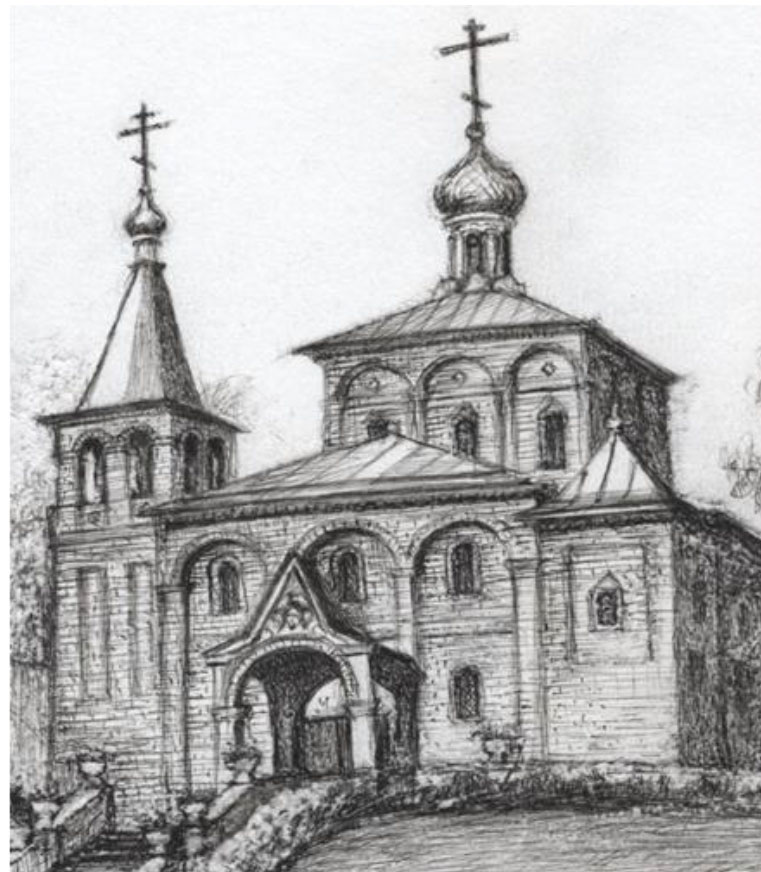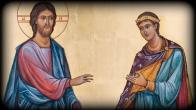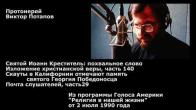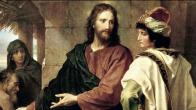You are here
Great Schism of 1054
The breakaway of the Roman Church from the Church Universal occurred in the following manner.
In the year 752, Pope Zacharias anointed Pepin the Short, the chief steward of the Frankish kings, to be king, and by this gave, as it were, the Church's blessing to the overthrow carried out by Pepin in the Frankish kingdom that removed the lawful Frankish king from power. For this, Pepin, in the year 755, took away from the Germanic tribe of the Lombards the lands conquered by them in Italy and delivered into the pope's hands the keys to twentytwo cities and the Ravenna Exarchate, which had previously belonged to the Byzantine Empire. Thus, the Pope was transformed from a subject of the Eastern Roman (Constantinopolitan) emperor into an independent secular sovereign, not dependent on any other sovereign, with an independent territory and with possession of supreme state authority on this territory.
This rapidly demoralized the papacy. The inner contradiction between the ascetic ideal and secular authority appeared as a dangerous enemy of the moral purity of the popes. It entailed a radical change not only in the status, but also in the behavior, in the intentions, in the aspirations and in the modi-operandi of the Roman popes. Conceit, pride, lust for power and the aspiration to subordinate all the local churches to their authority, which had previously appeared in the behavior of the Roman popes only as tendencies, as sporadic phenomena now wholly take possession of the popes.
At first, the popes set themselves the task of strengthening their authority in those Western churches the African, Spanish and Gallic Churches which did not form a part of the Roman Church. Despite a certain resistance on the part of the African Church, the popes succeeded comparatively easily in securing the subordination to themselves of these churches: great was the authority of Rome in these its former provinces.
As for the churches in Britain, Germany and in the other countries of Western Europe that were newly founded by missionaries of the Roman bishop, the popes succeeded in subordinating them to their authority all the more easily, inasmuch as the idea of the supremacy of the pope in the Church was inculcated in them simultaneously with the preaching of Christianity.
While subordinating to themselves the Western churches, the popes were simultaneously taking measures in order to substantiate their authority, if not dogmatically, then at least juridically. For this, a collection of ecclesiastical juridical acts was compiled in the West at the beginning of the ninth century in the name of Isidore, an authoritative Spanish sacred minister. Since both the name of the compiler and the contents of the collection, as was established later on, were spurious, it received the name of the "PseudoIsidorian Decretals." The collection consists of three parts. In the first part, there are fifty Apostolic Canons and sixty decretals of the Roman popes. Of these sixty decretals, two are partly falsified, while fiftyeight are altogether spurious. In the second part, among other spurious material, there is the spurious donation of the city of Rome by the Emperor Constantine the Great to the Roman Pope Silvester.
The collection was first published only at the end of the sixteenth century, and then scholars proved without difficulty the spuriousness of the documents that were in it. At the present time, even Catholic scholars do not recognize their authenticity. But at that time, the collection served as an authoritative basis for the development of ecclesiastical relations in the West, inasmuch as it was accepted on faith, and in the course of all the Middle Ages enjoyed the authority of authenticity. The popes began categorically to cite the decretals of the collection in substantiation of their rights to supremacy in the whole Church.
Pope Nicholas the First (858876) began first to cite the "PseudoIsidorian Decretals," since he first formulated sharply and decisively the idea of papal omnipotence in the Church. But the East, naturally, did not recognize this omnipotence. Pope Nicholas the First tried to subordinate the East to himself in a swoop. But he did not succeed in this. As a consequence of this failure, the Church schism appeared: for the first time in the ninth century, and definitively in the eleventh century (1054).
The external history of the falling away of the Roman Church is such. Because of the minority of the Emperor Michael III, the Byzantine (Eastern) Empire was ruled from the year 842 by his mother, Theodora, and the Emperor's uncle, Bardas. The patriarch in Constantinople was Ignatius (from the year 847). At the instigation of Bardas, the Emperor confined his mother in a convent; but the Patriarch, who before this had reproached Bardas for cohabiting with his daughterinlaw, opposed this. Bardas secured the deposition of Ignatius (in the year 852) and the elevation of Photius a man learned and worthy to the patriarchal throne. Enmity between the partisans of Ignatius and Photius began. On the advice of Bardas, the Emperor Michael decided to convoke a great council, to which he also invited Pope Nicholas the First. The latter decided to make use of the occasion and come out as the judge of the Eastern Church. He dispatched two of his legates to the council with a letter to the Emperor.
In it, he wrote that the Emperor had acted incorrectly, contrary to the Church canons, by having appointed one patriarch and by having deposed another without the knowledge of the pope. The Constantinopolitan Council (in the year 861), recognized Ignatius as deposed, and Photius as lawfully installed as patriarch. Pope Nicholas the First might well have recognized Photius as patriarch, if he had not seen in him a firm opponent of his pretensions to supremacy in the Church. He wrote a letter to the Emperor that declared Photius deprived of the patriarchal rank, and Ignatius restored. In the year 862, the pope convoked a council in Rome, which declared Photius deposed. In Constantinople, this enactment was not recognized, and a breach between the churches began.
The question of the governance of the Bulgarian Church intensified the inimical relations between the churches. In response to the arbitrary actions of the pope and his clergy in Bulgaria, Photius assembled a Local Council, at which he condemned all the Roman errors. In the year 867, a new council assembled in Constantinople, with representatives of the Eastern patriarchs, which again condemned the Roman errors and the pretensions of Pope Nicholas the First in the East.
At this time, the Emperor Michael was killed through the intrigues of his coruler, Basil the Macedonian, who occupied the imperial throne and sought support from the pope. In Constantinople, in the year 869, in the presence of papal legates, a council took place, which deposed Photius and recognized the supremacy of the pope and the subordination of the Eastern Church to him. But in the year 879, Ignatius died, and the Emperor Basil, who at that time no longer needed the pope, restored Photius. In the same year of 879, a council assembled in Constantinople with legates from Pope John VIII. Not one of the pope's conditions did the council accept; and the pope did not recognize the enactments of the council.
From the middle of the ninth century to the middle of the eleventh century, relations between the churches were indeterminate, and contacts between them were wanting, except for rare instances of correspondence by the emperors with the popes. In the middle of the eleventh century, relations were renewed, but only to end in a definitive breach. Leo IX was the pope at that time, and Michael Cerularius was the patriarch in Constantinople. The pope bethought to subordinate to himself certain churches in southern Italy that were subordinate to the Patriarch of Constantinople, while the latter then closed the Latin monasteries and churches located in Constantinople. For the regularization of mutual relations, the pope sent his legates to Constantinople, who behaved rudely and haughtily towards the patriarch. Bishop Arsenius, in "The Chronicle of Church Events," describes the action of the papal legates thus:
"And so, the papal legates, "having become bored by the opposition of the patriarch," as they said, decided on a most insolent action. On the 15th of July, they entered the Church of Hagia Sophia, and, while the clergy were preparing for the service at the third hour of the day on Saturday, they laid a bull of excommunication on the main altar in full view of the clergy and people present. Going out thence, they shook off even the dust from their feet as a testimony against them, according to the words of the Gospel (Mathew 10: 14)), exclaiming: "Let God see and judge."
Thus does Cardinal Humbert himself portray the deed. In the bull of excommunication, it was said incidentally: "As for the pillars of the Empire and the honorable, wise citizens, the city (that is, Constantinople) is most Christian and Orthodox. But as for Michael, who is unlawfully called patriarch, and the champions of his stupidity, innumerable weeds of heresies are scattered in it... Let them be anathema, let them be anathema maranatha (I Corinthians 16:22). Amen." After this, and in the presence of the emperor and his grandees, they orally pronounced: "whoever obstinately begins to oppose the faith of the holy Roman and apostolic throne and its sacrificial offering, let him be anathema, let him be anathema maranatha (that is, let him be excommunicated and let him perish at the coming of the Lord) and let him not be considered a Catholic Christian, but a heretical Prozymite (that is, those who do not accept unleavened bread and prefer leavened bread). So be it, so be it, so be it." The insolence of the papal legates stirred up the whole population of the capital against them; only thanks to the emperor, who esteemed their position as emissaries, were they able to freely depart."
In response, a Constantinopolitan council gave the papal legates over to anathema. From this time, the pope ceased to be commemorated in all the Eastern churches at the divine services.
Thus, the causes of the Church schism in the ninth and eleventh centuries were one and the same: the illegal pretensions of the popes to subordinate to their authority all the local churches, with the simultaneous, as we shall see below, deviations of the Roman popes from Orthodoxy in matters dogmatical, canonical and ritual. In this is the essence of the events, while those factual events that served as the concrete reason for the breach happened by simple chance. It was not a matter of individual facts, but the whole aggregate of the ideas and aspirations of the Romans popes of that time. The spirit of lust for power begat the idea of a great and dangerous untruth the unlimited sovereignty of the popes over the whole Universal Church.
This subordination of the papacy to a sinful principle occurred only from the ninth century. But when the Roman popes in the ninth century first formulated their pretensions, they did not present them as innovations, but, on the contrary, they naturally strove to prove that their authority was a right, everywhere and always recognized in the Universal Church.
So, from the ninth century, the Eastern and Western Churches have gone along different paths. The appellations which they themselves appropriated for themselves speak of the aims pursued by them: the Eastern Church began to call herself Orthodox, underscoring by this that her main aim is to preserve the Christian faith unharmed. The Western Church began to call herself Catholic (universal), underscoring by this that her main aim is the unification of the whole Christian world under the authority of the Roman pope.
©V.Potapov, 1996-98
PARISH LIFE
RECENT VIDEOS
Address of our Cathedral
Subscribe to our mailing list
While all the materials on this site are copyrighted, you may use them freely as long as you treat them
with respect and provide attribution on the Russian Orthodox Cathedral of St.John the Baptist of Washington DC.









